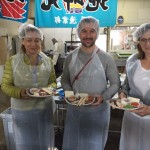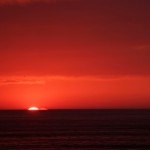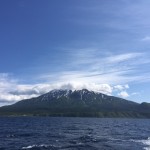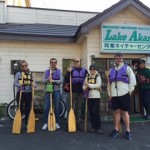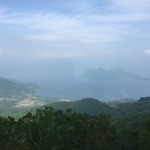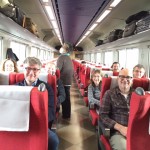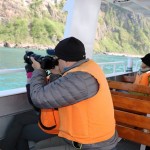Join me Hokkaido with Hiroko next year (2017), a unique tour combining the best of the culinary and natural worlds of the northern Japanese island of Hokkaido. This is the second year of operation. The complete information, including fare and application form, is available who which to receive them. Please write me at hiroko@hirokoskitchen.com or call me at 212-727-3085 (NYC). The tour is limited to nine (9) passengers.
HOKKAIDO with HIROKO, May 25- June 6, 2017
An Introduction
Welcome to Hokkaido with Hiroko, a unique tour combining the best of the culinary and natural worlds of the northern Japanese island of Hokkaido. This is the second year of Hokkaido with Hiroko operation. The group that joined Hokkaido with Hiroko 2016 enjoyed it thoroughly as you can see from the photos from the tour attached on this document.
You may have been to Japan many times; perhaps you have even joined one of Hiroko’s tours. If you have been to Japan you have probably visited Tokyo, Osaka, Kyoto and many other places in the country. But if you have not been to Hokkaido – all around this amazing island – you have not experienced a totally different Japan that Hiroko will bring to you. Hokkaido has a “frontier” feel. Outside of Sapporo, its only major city, it is not densely populated. That population is less than 3.5 million. Hokkaido is home to so much that is different from the rest of the country. A simple example: when you are out in the farm country, you will not see small rice paddies, but expansive fields growing wheat, corn, fruit, potatoes, cattle for beef and dairy products and most of the green vegetables found in Japan, and the barns are large buildings with colorful metal roofs. This could well be Europe or parts of America. Hokkaido has many national parks featuring nature that has not been disturbed by extensive human interference or habitation. Volcanic mountains – one less than 75 years old – and beautiful caldera lakes are separated by broad, fertile, cultivated valleys. Though the timing of this tour won’t allow you to enjoy them, it is the home Japan’s premier ski slopes and resorts. And, of course, the best seafood in the country – fish in so many varieties, shrimp, crabs of many kinds, oysters and the famous Hokkaido uni (sea urchin) and scallops – come from its nutrition filled water that result from volcanic materials and from the mixing of nearshore cold and warm currents.
Socially, Hokkaido is very different from the rest of the country. Its original population is the Ainu. The influences of these people are everywhere in place names, foods and local customs. And they survive to this day as a community that is, with other indigenous peoples, rediscovering and cultivating its roots. Extensive settlement by outsiders did not begin until the late 19th century, and the railway network tying the island together was not completed until 1926. This comprehensive tour personally researched and arranged by Hiroko welcomes your participation in this wonderful experience available to a very limited number of participants.
May 25, Thursday: CHITOSE
Arrive and meet at the ANA Crown Plaza Hotel Chitose (www.anacrowneplaza-chitose.jp). Chitose is adjacent to the New Chitose International Airport where you may arrive on domestic or international flight. It is a 15 minute taxi ride from the airport. If you are already in Sapporo, the capital city of Hokkaido, it is a short 30 minute train ride from the city to Chitose, and it is 7 minutes’ walk from JR Chitose Station to the hotel.
Orientation: The exact meeting time and place will be posted on a closed Facebook page: Hokkaido with Hiroko 2017. The address of the page will be given to the registered participants.
May 26, Friday: CHITOSE to NOBORIBDETSU
We leave by our private coach to Noboribetsu Onsen (hot spring town) by way of Lake Shikotsu and stay at the Boro Noguchi Noboribetsu Hotel (https://www.bourou.com/) for the first night of a two-night stay. The Boro Noguchi Noboribetsu Hotel is a modern, sophisticated hotel situated in this 150 year old onsen (hot spring) town. The hotel offers total relaxation, an excellent hot spring (each room is equipped with an individual onsen bath) and a great meal. Today we learn about the unique nature and history of this hot spring town area. We enjoy local specialty ramen for lunch and join a guided tour for Jigokudani Trekking: an easy walk through an area of sulfurous fumaroles and hot water vents. We stop at a foot-soaking hot bath for tired feet along the way. The dinner at the hotel is comprised of delicious Japanese fare utilizing seasonal Hokkaido ingredients.
Lake Shikotsu: Lake Shikotsu has a maximum depth of 363 meters and an average depth of 265.4 meters. It is the second deepest lake in Japan after Lake Tazawa. The water purity is incredibly high allowing visibility to a depth of 14 to 20 meters; one of the most clear lakes in Japan. There are many types of animals and birds in the area, including brown bear, red fox, red squirrel, chipmunk and mountain hare.
Noboribetsu Onsen: This area is a part of Shikotsu-Toya National Park and is an onsen town. Noboribetsu is famous for its Jigokudani, Hell Valley. Jigokudani is a spectacular valley just above the town of Noboribetsu Onsen that has hot steam vents, sulfurous streams and other volcanic activity. It is a main source of Noboribetsu Onsen’s hot spring waters.
May 27, Saturday: NOBORIBETSU to MT. USU GEO PARK
Leave by our private coach to Mt. Usu. Today we discover more about the fascinating past and current history of volcanic activity in the area. We see and learn about the area with a professional guide who is a trained geophysicist. We will have a delicious modern Japanese meal at a local restaurant featuring local seafood, meat and vegetables.
Mt. Usu and Mt. Showa-shinzan: Mt. Usu is a 737 meter high active volcano that was formed to the south of Lake Toya, about 20,000 years ago. At the foot of the mountain is Mt. Showa-shinzan which rose very recently during the period from 1943 to 1945. Unlike most mountains it is not millions of years old. It is national monument that actually caused neighboring mountains to move when it grew. The two mountains are protected as part of Shikotsu-Toya National Park. It is an area where the geological and natural wonders exist together with signs of historical human habitation from the Jomon Era (11,000BC – 300BC). It is a place of continuing geophysical and anthropological research and discovery. Mt. Usu and Lake Toya became the first Japanese representative of the International Global Geopark Network. It is known as the “Toya Caldera and Usu Volcano Geopark”. A cableway brings us in 6 minutes from the foot of Mt. Showa-shinzan to the top of Mt. Usu. There is a walking trail from the observation area at the cableway head-end to an observatory at the outer rim of the crater following a path through the multicolored other worldly volcanic area (yes, it’s safe, my guide, the geophysicist guide assured me). What can be seen on this walk cannot be experienced anywhere else.
May 28, Sunday: NOBORIBETSU to LAKE TOYA
Leave by our private coach to Lake Toya. Today we are pampered at one of the most beautiful scenic areas in the world by staying at the Windsor Hotel Toya
(https://www.windsor-hotels.co.jp/en/), high on a ridge above the blue caldera lake. This hotel was thew site of the G8 Summit Meeting in 2008. You will see photos of that meeting on the walls of the hotel. From the group of leaders who gathered here, only Angela Merkel remains in power. On our way to the hotel we stop at local vegetable farm and a local food store to see the bounteous products of land and sea in Hokkaido. After check-in at the hotel lunch is served to your room. You enjoy the lunch while admiring the beauty of the Lake Toya through the floor-to-ceiling wide window in your room. In the afternoon we embark on a private cruise on Lake Toya. We land on one of the islands in the lake to explore the local nature. We will enjoy a sushi kaiseki dinner at the hotel.
Lake Toya: Lake Toya is a volcanic caldera lake in Shikotsu-Toya National Park. It is a part of Toya Caldera and Usu Volcano Global Geopark. The stratified volcano of Mt. Usu lies on the southern rim of the caldera, and Mount Yotei (the “Mount Fuji” of Hokkaido) is to the north. The lake is nearly circular, being 10 kilometers in diameter from east-west and 9 kilometers from north-south. Lake Toya is the second most transparent lake in Japan. Naka-no-shima, an island in the middle of the lake is a fun trekking place. Lake Toya was called Kim’un (in the mountain) by the indigenous Ainu people. In the Meiji Period Japanese pioneers named the lake Toya after the Ainu expression ‘to ya’, which means ‘lake land’. The volcanic eruptions thousands of years ago and more recently have been continuously shaping nature in the region. The Lake Toya region is one of the most stunning and beautiful natural craters in the world.
May 29, Monday: LAKE TOYA to FURANO
Leave by our private coach for Furano. Furano sits in the center of Hokkaido. It is about four to five hours drive. On our way to Furano we drive through beautifull, meticulously tended, expansive farmland in broad valleys, a stark contrast to the volcanic area we have been seeing. I recommend that you relax and enjoy the first class rural scenery from the window. If you are familiar with the small rice paddy farms on the main Japanese island, these are quite a contrast. They are much larger with open fields and Western style barns all with very colorful roofs. This doesn’t look at all like the traditional travel brochure pictures of rural Japan. You could well be in Europe or parts of America. From this area come the grains and vegetables that supply all of Japan. Tonight we stay at the Furano Hotel, another jewel hotel (https://www.jyozankeidaiichi.co.jp/furano/). In the afternoon we make a bicycling tour of the vast and varied works of nature in Furano. If you are not keen on a bicycling tour, enjoy the garden of the hotel and strolling in the lovely surrounding neighborhood. Dinner is in the French style prepared by a talented chef, Naoki Komatsu, who has trained under Michel Bras in France. Chef Komatsu prepares his meal with Japanese precision, care and beauty. Yes, it is French, but with Hokkaido ingredients and Japanese techniques. This is a memorable culinary experience. This hotel recharges our body in the most pampered way.
Furano, Biei: Furano and Biei (“Bee-Aay”; like BA, as in British Airways) are towns in the center of Hokkaido, known for their beautiful and picturesque rural landscapes. At the time of our visit in May, the large fields are covered with different shades of greens. In July the local lavender fields there are in bloom and crowded with the troops of domestic and foreign tourists. We will miss the blooming fields, but, more important, we miss the crowds. In winter Furano turns into a very popular downhill and cross country skiing resort.
May 30, Tuesday: FURANO TO LAKE AKAN
We leave by a private coach for Lake Akan. Today we are heading to a very different part of Hokkaido – to the east. The coach takes us through the Tokachi Plain, the major food production area in Hokkaido. It grows 31% of Japan’s wheat, 33% of its potatoes, 33% of its azuki beans, 70% of its kidney beans, 44% of its beets and most of its buckwheat. There is also a considerable amount of dairy and livestock faming in the area. It is interesting that dairy farming here was introduced by Americans in the late 19th century. Before then dairy products were rare in Japan and not a significant part of Japanese culinary culture. Now, of course, there is milk, cheese, yogurt and ice cream everywhere in the country. Hokkaido is very famous for the highest quality buckwheat, and our coach takes us down a highway called the Soba-kaido (The Buckwheat Path). We stop at a soba restaurant on this road and take a soba noodle making class. Afterwards, we eat what we made – our delicious reward crafted with our own hands. Today we stay at Akan Yuku no Sato Tsuruga (https://www.tsuruga.com/en/), which stands in the small onsen town of Akan on the lake. We will have for the first time the experience of staying in true “Japanese ryokan” (country inn) ambiance. Here we will enjoy a superb multi-course ryokan dinner with local, seasonal ingredients.
Lake Akan and vicinity: Lake Akan is in the midst of Akan National Park, the oldest National Park in Hokkaido. The park is home to an abundance of wildlife and nature that can be enjoyed throughout the year. The Lake Akan area was and is also a home to indigenous Ainu people who came here to live and engage in commerce in this area. Here in the center of the village there is a museum dedicated to the Ainu people and culture and a sampling of the traditional buildings they constructed. We will visit the museum for a private educational event for our group.
May 31, Wednesday: LAKE AKAN to SHIRETOKO
In the morning before leaving for our next destination, we – those who can rise early after the previous evening’s delicious meal – enjoy early morning canoeing in the beautiful Lake Akan before breakfast. After breakfast, by our coach we head for Shiretoko National Park, a UNESCO World Natural Heritage Site, one of the most beautiful and wild national parks in Japan. On our way to this eastern-most part of Japan we stop at a must-see attraction, Lake Mashu. Tonight we stay the first night of two nights at the Shiretoko Daiichi Hotel (https://shiretoko-1.com/). We will relax and enjoy these most virginal natural surroundings and the magnificent seasonal seafood of the region. The dinner is at a casual local specialty at local restaurant.
Lake Mashu: Lake Mashu is one of the clearest bodies of water in the world. It is a crater surrounded by sheer cliffs 200 meters high and is completely inaccessible to people. The lake was formed less than 32,000 years ago as a volcanic caldera. Though you can’t get close to the water it is a spectacular sight from the cliff wall surrounding the lake.
Shiretoko: Shiretoko, a peninsula jutting eastward into the Sea of Okhotsk, is one of the few areas in Japan whose virgin natural surroundings have been preserved intact to today. Its rugged landscape, formed by volcanic activity, has long impeded human intervention and habitation; consequently, Shiretoko’s natural environment remains pristine and its diverse wildlife has been protected. Indeed, large parts of the park are completely inaccessible except by lengthy hiking. In July 2005, the Shiretoko peninsula was designated a UNESCO World Natural Heritage Site. Spring begins in late April, when the sea ice from the north disappears from the Sea of Okhotsk. In the forests, the arrival of spring is heralded by the buds swelling slowly on the trees. The streams sparkling with newly melted snow are garnished with yellow wild flowers. In many rivers, salmon and trout fry race toward the sea. Our visit in late spring will feature lush a sea of green, beautiful flowers and spectacular scenery. Three factors that make the Shiretoko Peninsula unique: A wide variety of climatic conditions and diverse flora are concentrated in a steep and narrow land area; the peninsula is surrounded by a rich ocean fed by volcanic minerals; a natural environment untouched by human intervention that stretches continuously from the warmer seashore to the alpine zone in the mountains. As a result, a large variety of wild animals exist in natural surroundings. The varied environment supports so many forms of wildlife. There have been 256 species of birds and 35 species of terrestrial mammals recorded on the peninsula. This includes the biggest population of large brown bears in Japan from whom we will keep a great distance.
June 1, Thursday : RAUSU AND SHIRETOKO
Today our private coach will take us by the winding road to the other side of Shiretoko Peninsula, to the town of Rausu. To do this we cross the Shiretoko mountain chain that runs down the center of the peninsula. At the pass and from the shore at Rausu we can see the disputed island of Kunashiri. During the final days of WWII Russia seized this and other islands from Japan and has not returned them. There is still no actual peace treaty between Japan and Russia for that reason. Yes, you really “can see Russia from here”. Rausu is a major kelp harvesting region, the origin of famous Rausu Komb as well as a major fishing port. And the abundant kelp forest is the ideal habitat for sea urchin. With a guide we will tour the Rausu wholesale fish market. It is not as big as the famous Tsukiji market in Tokyo, but this market is all about the wonderful locally caught very fresh fish. We then prepare our own seafood lunch from local seafood found at the market. No seafood tastes better than here. Returning to the other side of the peninsula, in the afternoon with a certified guide we will enjoy Shiretoko Goko (Five Lake) Trekking. This is where the largest species of bear, the brown bear, co-exists with locals and tourists. Don’t worry; the guide is equipped to handle any rare encounter with those creatures. We will enjoy dinner at local restaurant. At the hotel please enjoy a hot bath before, or after the dinner or at both times.
Shiretoko Goko: Shiretoko Goko are five lakes hidden in the native forest of the Shiretoko Peninsula. The area is famous for its untouched, wild nature and the brown bears and other animals living there. Bear tracks were present during my walk around the lakes, but no bears were seen. The lakes are of different sizes and depending on the weather of the day, they offer beautiful reflections of the central mountain range and nearby trees. I took the pictures you see with my iPhone. That’s Mount Rausu, the highest peak in the chain on the right. We will learn a lot about the flora and fauna, the bears and other animals living in the area. Before the walk we will watch a short video to prepare for a safe walking trip.
June 2, Friday: SHIRETOKO to ABASHIRI
In the morning our private coach takes us to a Shiretoko Sightseeing Cruise. We travel by boat along the coast of the National Park to inaccessible areas seeing cliffs and rock formations, waterfalls and bird life. After the cruise we take a short walk to Fuleppe Falls.
In the afternoon our private coach drives us to Abashiri, west of Shiretoko Peninsula. Abashiri, the largest town on the Okhotsk Coast of northeastern Hokkaido, is a product of the fishing and tourism industries. With the opening of the railway here in 1912, and the construction of a port in 1919, Abashiri has played an important role in land and sea transportation. We will take a private Nature Cruise in the Sea of Okhotsk. We do hope to see minke whales, porpoises and variety of sea birds. We check-in at Hokuten no Oka Tsuruga Resort (https://www.hokutennooka.com). We will enjoy a seafood and beef shabu shabu dinner at a local restaurant.
June 3, Saturday: ABASHIRI
In the morning our private coach drives us to the Gensei Horse Farm. Today we enjoy horseback riding along the coast of Sea of Okhotsk. All necessary riding gear is supplied and no previous horseback riding experience is necessary. Our journey is on well behaved gentle horses accustomed to riders with little or no experience. The pace is pleasant and enjoyable; the scenery is breathtaking. After the horseback riding we visit Cape Notoro. We see happy horses and cows grazing on the green grass carpet on one side and the expansive Sea of Okhotsk on the other side.
Tonight we savor a local sushi dinner at a nearby specialty restaurant.
Sea of Okhotsk Coast: The sea of Okhostk is famous for ryuhyo, drift ice in the winter. The ice forms near the mouth of the Amur River in Siberia and is propelled by currents and wind, until it rolls onto the coast of Japan. At the beginning of the journey it is more like the consistency of sherbet. Then, as it moves across the sea it gradually grows into a hard mass before arriving at the Japanese coast. Drift ice varies in its shape due to the effects of wind and tide. The final forms are magnificent presentations of art sculpted by nature. During our visit in early summer the ice is, of course, gone. But at that time lovely green vegetation appears and the sky is most often deep blue and clear. The ubiquitous and colorful early summer flowers of the area entertain both natives and the visiting tourists.
June 4, Sunday: ABASHIRI to WAKKANAI
Today by our private coach we leave for the northern most Japanese town of Wakkanai. It was established in the 19th century as a frontier trading post for commerce with the aboriginal Ainu people who then inhabited much of Hokkaido. It adjoins Japan’s northernmost point, Cape Soya (45°24’33″N), from where the Russian island of Sakhalin can be seen 43 km away on a very clear day. From Abashiri to Cape Soya is about 6 hours’ drive with stops we will make along the shore road. As we proceed north the traffic becomes sparse and the scene is broken by a small few fishing villages (all with high speed fiber optic Internet service and satellite TV; don’t forget, this is, after all, still Japan). We will stop at a roadside shops and restaurant for a quick bowl of scallop ramen for lunch. Relax and enjoy the scenery of both the sea on the right and farm land on the left. On the land side of you will spot many dairy farms and advertisements for their freshly produced milk and milk products – not a typical image of Japan. The route is known as The Milk Road. We will stop at Cape Soya and see the monument – an excellent photo op – marking the northern-most point of Japan, and, if we are very lucky, we will see Sakhalin in the distance. Tonight and tomorrow night we will stay at ANA Crown Plaza Wakkanai (https://www.anacpwakkanai.com/). This evening we will venture out to savor the northernmost specialties at a local restaurant.
Wakkanai: Wakkanai prospered through trade and as a strategic outpost in the far flung northern reaches of the old empire. This modern city was established in 1900, and when Japan captured and colonized parts of Sakhalin Island after the successful Russo-Japanese war of 1905, it became the main transit point by regular steam ship to the town of Otomari (now Korsakov) in Karafuto prefecture that was established in Sakhalin. The status of the area and city increased when the Soya railway line was finally extended here from the south to the town in 1926. With the loss of Sakhalin (and the islands we saw from the Shiretoko Peninsula) in the aftermath of WWII the town’s fortunes declined, and it reverted to being little more than a military post (a large base with US personnel during the Cold War was nearby and it remains a Japanese base and airfield to this day). But the town remains a continuing point of contact and trade between Russia and Japan. Indeed, there is a daily ferry to Sakhalin. You will be surprised to see bi-lingual Russian and Japanese signs throughout the city and on store fronts. The port is now, however, the center for fishing boats bringing in rich harvests of shellfish such as crab, sea urchin and scallops. It is the embarkation point for ferries to the nearby Japanese islands of Rishiri and Rebun, both of which are designated as national parks.
June 5, Monday: RISHIRI ISLAND
Today in the early morning we take a ferry to Rishiri, a small island about 20 kilometers off the Hokkaido coast. Mt. Rishiri, known as Rishiri Fuji because it has the shape of Mount Fuji, is a dormant volcano, sits in the center of the island. This small island is famous in Japan for it Rishiri Kombu, the highest quality kelp produced in the country. This product is adored by the most honored Kyoto chefs. We will tour the island by a guided coach. We will visit a fishermen’s store where they showcase varieties of Rishiri Kombu products. And for us, the most famous product of this small island is the best sea urchin, uni, in Japan that we will, of course, enjoy during our visit. Tonight we will have farewell teppan-yaki dinner composed of delicious locally raised beef and seafood at a restaurant in the hotel.
Rishiri Island: Rishiri Island is about 60 kilometers in circumference. Together with the neighboring Rebun Island, Rishiri belongs to the Rishiri-Rebun-Sarobetsu National Park. Alpine flowers bloom everywhere in the island even un low altitude areas because of the northern latitude.
June 6, Tuesday: WAKKANAI to SAPPORO
Today we will take the Soya Express train from Wakkanai Station, the northernmost train station in Japan, to Sapporo Station. The train leaves early in the morning. The journey is about 5 hours. This is a last chance to admire the beautiful scenery in Hokkaido. After arriving at Sapporo Station the tour is concluded and you may go to your hotel in Sapporo (a lovely city with its nearby historical port of Otaru) or you may continue by easy rail transfer at Sapporo station to New Chitose Airport for a flight to Tokyo for a departure to your home country or other international destination or to other major cities in Japan to continue your stay in the country. Goodbye to Hokkaido and to everyone who joined this marvelous tour.


